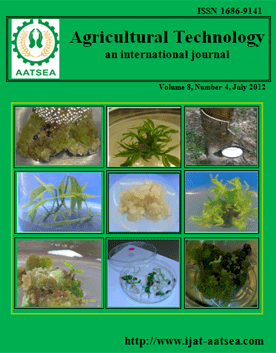ThaiScience
ThaiScience
INTERNATIONAL JOURNAL OF AGRICULTURAL TECHNOLOGY
Volume 17, No. 01, Month JANUARY, Year 2021, Pages 87 - 102
Genetic analysis of panicle architecture traits in f5 from single cross of local rice varieties for developing high yielding new type of upland rice
Herawati, R., Masdar, Alnopri and Widodo
Abstract Download PDF
The panicle architecture is a decisive traits to increase the production of new types of rice, namely panicle length, number of primary branches, grain length, grain thickness and grain length/thickness ratio. The research was to map the architecture of panicles genetically in the F5 population to get the best individuals resulted from the selection in the development of a new type of upland rice. F4 seeds were used as materials which consisted of 281 numbers from single outcrossing of local varieties. The augmented design was performed with Sriwijaya, Bugis, IR7858, and IR-148+ being the control varieties. The estimation of heritability of panicle architecture traits in the F5 population showed high criteria, which ranged from 0.57-0.80. The coefficient of genetic diversity (CGD) of panicle architecture ranged from 10.12% -48.2% with moderate to broad criteria. All of the observed traits of panicle architecture were not significantly different among individuals within the population, indicating that the F5 population had a normal distribution, and did not have skewness controlled by additive genes. The strong phenotypic correlation between the length and weight of the panicle with all the other were observed characters. The weight of a panicle was positively correlated with its length, its axis length, number of primary branches, number of secondary branches, number of spikelets, 1000-grain weight, and grain density, indicating that the weight of a panicle was determined by its length, which increased the density of its primary and secondary branches. It is concluded that the high yield of upland rice can be predicted from the yield-affecting characters of panicle architecture, namely the number and the length of primary and secondary branches, and the grain density.
Keywords
Panicle architecture, Upland rice, High yieldINTERNATIONAL JOURNAL OF AGRICULTURAL TECHNOLOGY
Published by : Association of Agricultural Technology in Southeast Asia (AATSEA)
Contributions welcome at : http://www.ijat-aatsea.com
